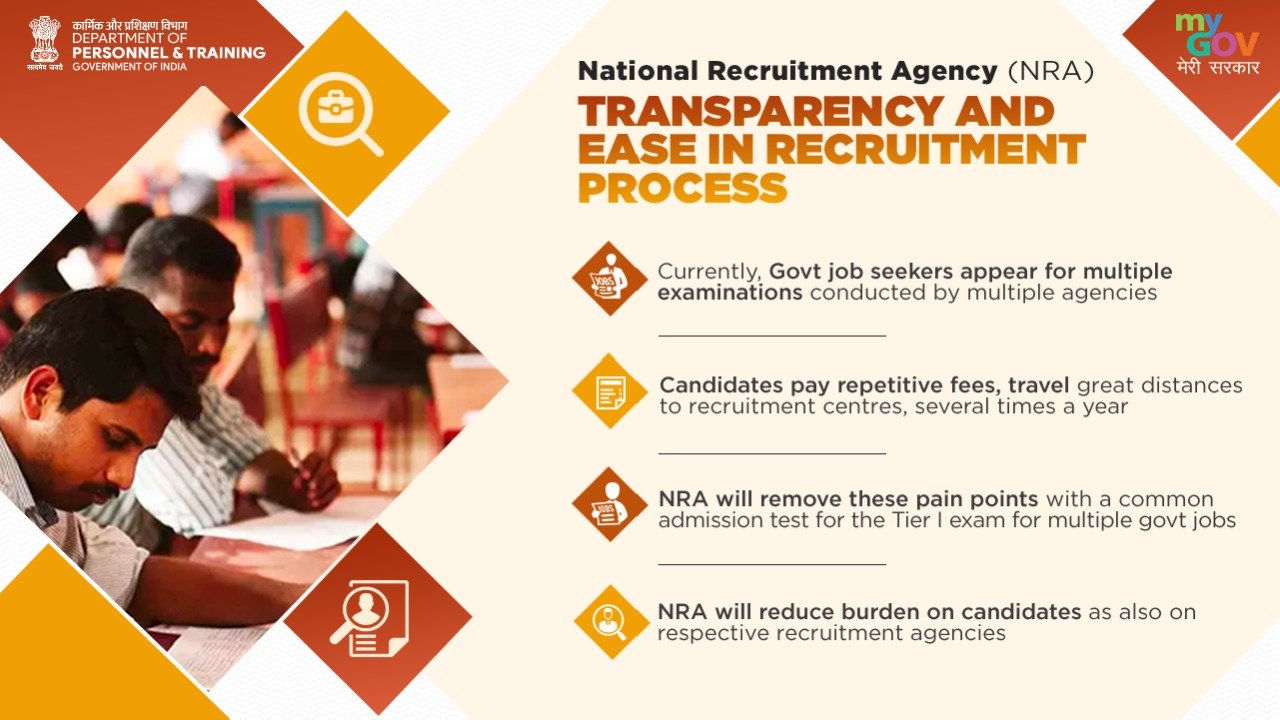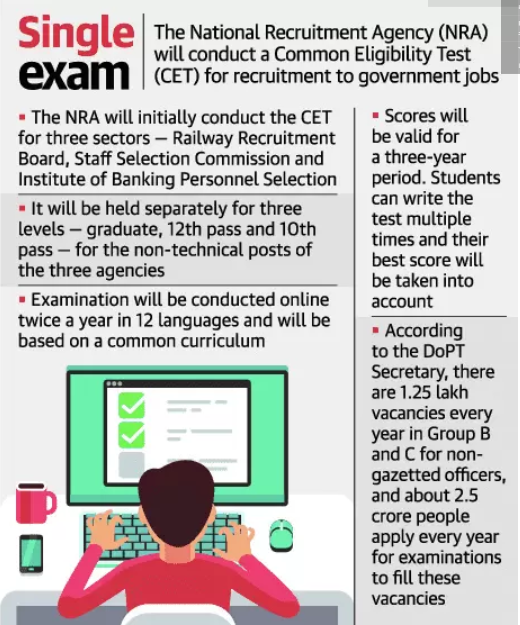National Recruitment Agency
2020 AUG 21
Mains >
Polity > Institutions/Bodies > Other Bodies

IN NEWS:
- The Union Cabinet has approved the setting up of National Recruitment Agency, an independent body to conduct examination for government jobs.
WHY IS NRA NEEDED?
- Multiple agencies: At present, candidates seeking government employment have to appear for separate examinations conducted by multiple recruiting agencies for various posts. Candidates also have to pay to each recruiting agency for each exam.
- Urban centric: The choice of examination centres are far and few. Candidates have to travel long distances for appearing in various exams, most of which are concentrated in major urban areas.
- Linguistic barrier: Presently, examinations for recruitment to Central Government jobs are held only in English and Hindi. This is a major challenge for candidates who come from different regions of country.
- Delayed process: The present recruitment cycle takes years to complete, and is often marred by clashing dates, judicial interferences and examination scams.
- Cost of recruitment: Recurring exams and the large number of applications creates major challenges for the agencies, particularly in areas of conducting exams on time, manpower management, security and logistics. This adds to the cost of recruitment.
- Pressure on candidates: Currently, those who pass the first level (Tier 1), but fail in higher levels (tier 2) have to again appear the next year and start afresh. This creates immense pressure on the candidates and affect their performance.
FEATURES OF NRA:
- NRA has been envisioned as ‘a specialist body bringing state-of-the-art technology and best practices to the field of central government recruitment’.
- The setting up of NRA was announced in the Union Budget by Finance Minister Nirmala Sitharaman in February, 2020. NRA will be an autonomous society registered under the Societies Act.
- It will be headed by a Chairman of the rank of the Secretary to the Government of India. It will have representatives of the Ministry of Railways, Ministry of Finance/Department of Financial Services, the SSC, RRB & IBPS.
- NRA will conduct a Tier-1 Common Eligibility Test (CET) for all non-gazette posts, including Group B and C (non-technical) jobs.
- Features of CET:
- The CET will be conducted in 12 languages and based on a common curriculum.
- There will be a common registration and single fee. The test will be held twice a year. CET will be conducted separately for graduate, higher secondary and matric levels.
- Examination centres will be set up in each district. Scores will be generated quickly, delivered online and be valid for a three-year period.
- Based on the preliminary screening done using the CET score, final selection for recruitment shall be made through separate examination (Tiers II, III, etc.), which shall be conducted by the respective recruitment agencies.

- A standardised question bank with multiple questions of similar difficulty levels will be created in a central server. An algorithm will be used to jumble and dole out different questions, so that each candidate receives a different question paper.
- Though the Centre envisages to use the CET score for all recruitments in the future, this will initially be implemented only in three agencies:
- Railway Recruitment Board
- Staff Selection Commission
- Institute of Banking Personnel Selection
- The government has sanctioned a sum of Rs 1517.57 crore for the NRA. The expenditure will be undertaken over a period of three years.
BENEFITS OF NRA:
For candidates:
- Decongest recruitment process: There are 1.25 lakh vacancies every year in Group B and C for Railways, banks and SSC. About 2.5 crore people apply for these examinations every year and they have to apply for each exam separately. NRA will avoid this situation through the Common Eligibility Test.
- Saves time and energy: Candidates who clear CET once will not have to appear for the screening test again for three years. They can write the test multiple times as long as they are within the eligible age limit, with their best score being taken into account. This way, CET will save their time and energy.
- Reduces financial burden: CET will be held in 1,000 centres across India in a to bid remove the currently prevalent urban bias. Candidates can choose centres and would no longer have to travel at considerable expense and hardship to take an employment test or pay for multiple examinations.
- Better accessibility for women: The availability of exam centres in every district would benefit the female candidates, as most of them currently depend on a guardian to accompany them in reaching their exam centres.
- Benefit of regional language: Presently, most of the exams are conducted in English and Hindi languages. CET would be available in a number of languages, benefitting aspirants from different regions of country.
For recruiting agencies:
- Reduces burden: Multiple recruitment examinations are a burden on the recruitment agencies because of repetitive expenditure, law and order/security related issues and venue related problems.
- Reduced cost of recruitment: Rs 600 crore savings is expected for different recruiting agencies. In the future, CET scores can be shared with central and state governments, PSUs and private sector, who can use it for their recruitments, thus further reducing recruitment costs.
- Faster recruitment: Some states and departments, such as Madhya Pradesh, have already decided to skip their second level test and go ahead with the recruitment based on CET scores.
Other benefits:
- Transparency: The present recruitment cycle takes at least 18 months and is often marred by clashing dates and examination scams. An independent, professional, specialist Organisation, a common exam, standardized question bank and IT-enabled tools will help avoid these issues and improve transparency in recruitment process.
- Support for aspirational districts: There will be a special thrust on creating examination infrastructure in the 117 aspirational districts. The proposal is expected to ease the access to aspirants residing in rural areas.
|
Transformation of Aspirational Districts:
Launched in January 2018, the ‘Transformation of Aspirational Districts’ initiative aims to expeditiously improve the socio-economic status of 117 districts from across 28 states. It is anchored by NITI Aayog at the national level. The broad contours of the programme are:
- Convergence (of Central & State Schemes) which brings together the horizontal and vertical tiers of the government.
- Collaboration (of Central, State level ‘Prabhari’ Officers & District Collectors) which enables impactful partnerships between government, market and civil society.
- Competition among districts driven by a spirit of the mass movement, it fosters accountability on district governments.
With States as the main drivers, this program will focus on the strength of each district, identify low-hanging fruits for immediate improvement, measure progress, and rank districts.
|
WAY FORWARD:
- Increase public employment: With growing emphasis on transferring core areas like railway services to the private sector, there may be fewer government jobs on offer in the future. Hence, the long-term relevance of NRA will depend on the commitment of governments to raise the level of public employment and expand services to the public.
- Bring states on-board: Jobs under the Centre, predominantly in the railways and defence sectors, constitute around 14% of public employment, with the rest falling within the purview of States. Hence, it is crucial to have the states adopt the NRA for it to be effective.
- Strengthen connectivity infrastructure: The success of NRA depends on how well it can conduct exams. For this, a robust system of computers, internet and allied infrastructure is essential. To ensure the same, scope of initiatives like BharatNet can be leveraged.
- Capacity building: The entire process of candidate selection must be a model, marked by well-defined procedures, trained staff and wide publicity for the process. Also, the candidates must be properly trained and familiarized with the online nature of examination.
- Ensure authenticity: There is a need to ensure the authenticity of claims by candidates regarding their CET scores. For this, unique identification numbers, digital certificates and single window verification systems must be developed.
PRACTICE QUESTION:
Q. Enumerate the salient features of ‘National Recruitment Agency’. How will it enhance the recruitment process in the country?

